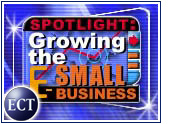
Hewlett-Packard (NYSE: HWP) currently offers its products and services — including printers, computers, handheld devices, servers, software, electronic payment solutions, and consulting services — to customers in more than 120 countries.
The Palo Alto, California-based company sells directly to consumers via real world stores, as well as through its HPShopping.com site. HP ranks 19th on the Fortune 500 with revenues of nearly US$49 billion over a 12-month period ending April 30th.
Shirley Choy-Marshall, director of marketing for HPShopping.com, recently spoke to the E-Commerce Times about how HP uses the Internet to reach potential customers. Choy-Marshall believes that online advertising has distinct advantages over traditional advertising, but that the dynamic nature of online advertising can be challenging for advertisers as well.
Action Packed
ECT: What advertising advantages does the Internet offer that other media do not provide?
Choy-Marshall: Advertising online has several advantages over other forms of media. First, it provides quick results. Depending on who you are advertising with, you can know how your campaign is doing in real time, daily or weekly. Advertising online helps us to reach people who are buying online easier than other forms of media. It also provides a more effective “call to action” for consumers because it is easier to click a mouse than to tear out an ad and remember to visit that site later.
ECT: What steps, or series of steps, do you take when planning an online advertising campaign?
Choy-Marshall: There are a few things we typically do. We look at our seasonal advertising and determine what our objectives are. Are we building site awareness? Launching a new product? After determining our objectives, we determine what sites to advertise on.
We look at which sites have done well in the past, and because the online advertising market is somewhat shaky, we also look at the viability of sites we advertise on. Other factors are whether a site’s privacy policies are in line with ours and whether or not the content is compatible with HP’s brand identity. When HP is advertising on a network of sites, it also monitors the campaign and pulls banners if they show up on pages with content that is incompatible with HP’s brand.
There is also an element of testing. We may be testing different types of sites or new types of banner ads.
Packing Punch
ECT: Should an online advertiser choose many sites on which to advertise — or spend the same amount for a larger buy on one site?
Choy-Marshall: Sites just starting out may not have as much experience as HP and during the first few months they should try a bunch of sites to see what works. Even though HP has experience with online advertising, we keep adding new sites to the mix to make sure we’re not missing the next latest and greatest thing.
When choosing sites to advertise on, HP looks for sites with logical tie-ins to the products we’re advertising. For instance, ads for handhelds appear on financial sites such as CBS Marketwatch and ads for DeskJet printers appear on parenting and family sites because HP’s research has shown that families use DeskJet printers for projects with kids.
Sometimes it makes sense to establish long-term relationships with advertisers. HP currently has long-term marketing relationships with Yahoo! and AOL.
ECT: What process do you use to determine how much of your overall advertising budget is allocated to a particular site?
Choy-Marshall: We get out the crystal ball (laughs). Seriously, how much success a site has had in the past is a determining factor in how much HP allocates to that site.
Tap Dancing
ECT: What are the biggest challenges of marketing via interactive media?
Choy-Marshall: It is so dynamic. You have to stay on your toes and evaluate it constantly. In many ways, we’re at the mercy of other sites. A site that worked well may all of a sudden have declining results with no explanation or a site may undergo a redesign, which causes a decline in results.
ECT: Is the Internet better suited for branding campaigns or lead generation?
Choy-Marshall: I think it can be good for both. Although there has been a decline in the success of banner ads, they are still good for branding. As consumers see an ad for the same company over and over, the images get burnished into their mind. The right site and the right area of a site can also lead to results in terms of sales. Shopping areas within major portals have good lead generation and we’ve found that it makes perfect sense for HP to advertise at tech sites. We’ve also gotten some placements in product listings that look almost like content.
Banners at Work
ECT: What advantages have you gained through running a banner ad campaign?
Choy-Marshall: The No. 1 thing we’ve gained is that it has allowed us to keep our name out there and stay in the game. Banner ads have also worked well in getting consumers to enter sweepstakes and sign up for newsletters.
ECT: What advantages have you gained through marketing in e-mail newsletters?
Choy-Marshall: Huge advantages. HP is keen on creating a relationship with customers and starting a dialogue with customers. The nice thing about the e-mail newsletter is that we know they are interested in our products. We also provide a way for consumers to give us feedback and do periodic surveys to find out how consumers feel about HP. We also make sure to include our phone number in the newsletter, so consumers have a way to contact us.
Big Impact
ECT: Have the new larger ad sizes had an impact on your advertising campaigns?
Choy-Marshall: We’ve tried some larger sizes and they’ve worked for us. They’ve been leading to higher click-through rates. Although the conversion rate has remained about the same, a higher click-through rate has given us more conversions overall.
ECT: What are some successful strategies for online advertising?
Choy-Marshall: We spend the majority of our buy on sites that have worked for us in the past. Hypothetically, we might spend 75 percent at tried-and-true sites and 25 percent on new sites. This way we know we have 75 percent we can bank on and the other 25 percent is like gravy.
ECT: What pitfalls should an online advertiser try to avoid?
Choy-Marshall: To be sold by smooth-talking reps who try to over-promise. Advertisers need to ask for concrete examples. Make sure the site delivers what you want. Don’t be seduced by a sales pitch. Additionally, be clear about your expectations and establish the metrics that are important to you upfront. It’s also good to work in some kind of guarantee as to the minimum results you can expect from the site.
Measuring Tape
ECT: Are there products or services that are not suited for promotion through online advertising?
Choy-Marshall: I would say there is some way to promote just about anything online. All our products lend themselves to online advertising.
ECT: How do you measure the effectiveness of your Internet marketing campaign? What factors come into play?
Choy-Marshall: There are many different types of return on investment. We measure click-through percentage, sales, and how many subscriptions to our newsletter and entries into sweepstakes are generated.
The Right Stuff
ECT: Based on your experience with Web marketing thus far, what does the future hold for online advertising — both in terms of strategy and technology trends?
Choy-Marshall: We believe there is a lot of promise. The real onus is on companies providing advertising space to provide a unified product to offer clients — something that carries through both online and offline. On the technology side, we’ll see more interactive advertising that provides a deeper level of information. There is a lot possible that we haven’t seen yet.
ECT: What advice do you have for a company starting to plan a new online advertising campaign?
Choy-Marshall: I’ll reiterate what I said earlier. It’s important to be clear on your objectives and choose sites carefully, because not all sites are right for all businesses. Do a lot of testing and make sure the site is a good match in terms of your company’s brand and identity.![]()














































Social Media
See all Social Media